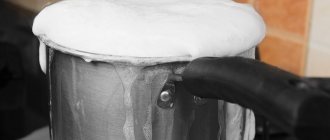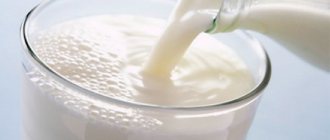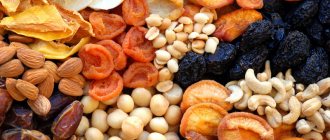Milk is a popular product consumed by adults and children. It is included in many dishes. It is often recommended to purchase a “live product” from the market. But such milk must be boiled for a child. After all, it can contain harmful microorganisms and can transmit some diseases from the cow. Boiled milk is a safe product. Boiling kills dangerous bacteria, as well as lactic acid microorganisms, which shorten the shelf life. But it is important to know how to do it correctly, how long to boil the milk, and in what container.
Do you need to boil store-bought milk?
Not everyone understands why boil milk. Doctors recommend that even products purchased from friends be subjected to heat treatment. Residents of rural areas have no doubt whether it is possible to drink raw milk; they do it regularly. But during milking, harmful microorganisms can enter the liquid from the cow’s udder, the milkmaid’s hands, and dishes. And in milk they multiply quickly. Tuberculosis, tularemia, and brucellosis are transmitted from a sick cow. Raw milk also contains female sex hormones. Therefore, it is imperative to boil the product before use.
Some people wonder if store-bought pasteurized milk needs to be boiled. Pasteurization is a high temperature treatment that kills all microorganisms. Therefore, store-bought products are safe and do not need to be boiled. If the recipe calls for hot liquid, you can heat it slightly without bringing it to a boil.
List of reasons for sour milk
Once the milk is boiled, it curdles and separates into lumps and whey in the pan. But if the process occurs before the required shelf life, the product acquires a sour taste and smell, there are explanations for this.
Diseases
Changes in the composition, consistency or reactions of milk often occur due to inflammation or infection. Some of them occur in an acute form, some more covertly:
- mastitis affects the souring process of the product. Inflammation of the udder causes an increase in the number of harmful bacteria. They get into the milk and cause fermentation. It has to be treated with antibiotics. You should not drink milk at this time;
- a follicular ovarian cyst causes the product to quickly curdle when heated and sour, acquiring a bitter taste. When a cow is sick, milk is given in smaller volumes. The cyst must be treated with the help of a specialist;
- Among the causes are ketosis. This is a metabolic pathology due to improper feeding. During this period, excess acetone and acetic acid are found in milk. To help the animal recover, the diet is changed and vitamins are introduced.
Storage and milking methods
One of the simple factors influencing the rapid souring of milk is the storage temperature.
Thus, in the refrigerator this process and oxidation of the product proceeds more slowly than at room temperature.
Another reason why a cow’s milk quickly turns sour is basic unsanitary conditions:
- washing hands and clean clothes should be the first rules when milking;
- The milk container is provided not only clean, but also dry;
- the udder is cleaned with warm water and wiped dry with soft tissues;
- The paddock must be cleaned of dirt and manure and bedding regularly changed.
Cow diet
The cow's food affects the quality of milk. The healthier, fresher and more complete the diet, the richer and richer the composition of the product will be.
For example, in the second half of summer some herbs begin to bloom. Why does a cow have a lot of milk in this season, but sometimes it quickly disappears? Many of the plants affect the taste of milk and help reduce its shelf life. These include fresh beet tops. Before giving it to the cow, the tops are dried for several days. Then the oxalic acid evaporates.
How to boil milk
To make a product that is not only safe, but also tasty, you need to know how to boil milk correctly. During industrial pasteurization, it is heated to 75-80˚ and kept for half an hour. It is difficult to achieve such processing at home, so it is recommended to bring it to a boil. This process is simple, but requires attention and compliance with the rules.
- Pour cold milk into the pan a little more than half the volume.
- Place on low heat.
- Stir constantly to remove any foam that forms.
- When foam begins to form, reduce the heat further.
- Boil for 1-2 minutes, remove from heat and cool. To preserve beneficial microelements, it is better to use a bowl of cold water.
It is important to know how long to boil milk. A pasteurized product can be brought to a boil and turned off. But raw milk is boiled for 2-3 minutes. Stir all this time to avoid burning and running away. Cooking longer is not recommended so as not to destroy the nutrients. The foam that forms after boiling contains useful microelements; it should not be thrown away; it is better to stir it in liquid.
It is important to keep the container in which the milk is boiled clean. It strongly absorbs odors, even those that are barely noticeable. After boiling, the aromas will be felt stronger. Therefore, it is recommended to use separate dishes.
Sometimes you only need a glass of boiled milk, for example, for a child. In this case, fiddling with a large container and boiling on the stove is long and tedious, so housewives will be wondering whether it is possible to boil milk in the microwave. People usually use a microwave oven to heat up food, but it can only bring a small amount of liquid to a boil. There are several rules for this preparation:
- the microwave heats the liquid unevenly, so turn it on 3 times for 20 seconds, each time removing the cup and stirring the contents;
- pour into 2/3 of the container, when heated the liquid increases in size;
- It is worth putting a wooden spoon or skewer in the cup, through which steam will escape, this replaces stirring.
Why do this?
By raising a cow yourself and properly caring for it, you don’t have to worry about drinking fresh milk. But when buying from other farmers, you need to play it safe and take into account the boiling procedure.
The reasons why you should definitely boil your homemade product are as follows.
- Possibility of transmitting diseases to animals. As a result of this fact, dangerous microorganisms can also get into milk. Improper cow care leads to the same result.
- The product may contain antibiotics. There is a possibility that they were fed to the animal to prevent disease.
- Due to the content of lactic acid bacteria, fresh milk can turn sour immediately on the day of milking.
- The person who milked the animal may not have adhered to the established rules for the procedure.
- The storage and transportation of goods may have been carried out without observing sanitary standards.
When boiling, the following elements disappear:
- pathogenic bacteria from the skin of a cow, a milkman or from the air (the boiling process helps kill brucellosis, for example);
- lactic acid bacteria, which are necessary for fermentation (but thanks to this fact, the product is stored longer);
- enzymes that allow young children to digest formula (adults can get them from fermented milk products);
- vitamin C and some others, which are not very resistant to heat treatment (but there are very few such components in the initial product);
- immunoglobulins needed only by calves.
But at the same time, the product retains:
- calcium is the most important and useful component;
- a significant proportion of vitamins and microelements;
- fats and milk protein.
Despite all these facts, even a glass of boiled milk or regular store milk contains a small amount of antibiotics that are resistant to high temperatures, which are added to animal feed in industrial production.
The milk is burning, what should I do?
Often this product burns when boiled. The reason is the protein, which at high temperatures coagulates and sticks to the bottom and walls. But there are ways to avoid such trouble. To do this, let’s find out which container is best to boil in? Enameled and ceramic containers are not suitable - milk burns more easily on enamels and paints. Pots used:
- glass;
- aluminum;
- made of stainless steel.
The dishes must have a thick double bottom. This ensures even heating. You can place an inverted saucer on the bottom. Choose a large capacity container with high walls. You cannot fill more than 2/3 full.
Do not cover the pan with a lid. During boiling, you need to constantly monitor the liquid and stir it. This is necessary for uniform heating and helps avoid burning.
There are several tips that will help you boil milk without problems.
- First, pour some water into the bottom and bring to a boil, then add milk. The water will evaporate quickly, but will prevent burning.
- Boiling should take place over low heat. When heated quickly, it is guaranteed to burn.
- You can grease the bottom and walls of the dish with butter. This will protect against burning.
- If you have a slow cooker, it is better to use it for boiling. The device provides uniform heating.
If the milk is burnt, you can save it. Immediately pour into a clean container, after straining several times through cheesecloth. Then add a pinch of salt and stir well. To cool quickly, place the container in a bowl of cold water. Another way is to put a piece of dry bread wrapped in gauze. This will help eliminate the rancid smell.
How to clean a pan from burnt milk
If the milk is burnt, the dishes should be cleaned as soon as possible; dried burnt residue will be more difficult to remove. You need to immediately fill the container with cold water, clean it with a brush and drain it. You can remove burnt milk residues using various cleaning products. The choice depends on the material of the cookware. There are several cleaning methods.
- If the dishes are covered with a brown coating on both sides, place them in a large container. Boil for an hour and a half in water with soda - 1 pack per 5 liters.
- In an enamel or aluminum pan, pour 5 tablespoons of salt and soda on the bottom. Pour in a small amount of warm water and leave overnight. In the morning, pour out the solution and boil clean water.
- Grind activated carbon. Sprinkle the powder onto the burnt spot and leave for half an hour. Then pour cold water and leave for another half hour. After this, clean with a brush and detergent. Do not use a wire brush for enamel.
- If the dishes are aluminum, pour in table vinegar, close the lid and leave for several hours. The acid will soften the carbon deposits. After this, the stain will be easy to wipe off with a sponge. Citric acid has the same effect. For dishes made of other materials, you can use whey. Pour it onto the stain and leave it for a day.
- In addition to ready-made cleaning products, you can use homemade ones. Add 20 g of grated laundry soap, 30 ml of ammonia and 90 g of crushed chalk to 60 ml of water.
Tags
Milk Milk boil milk and such milk for store-bought milk boil milk Milk burns Why milk runs away Milk has curdled boiled milk Why boil milk must be boiled or boil store-bought cows. Boiled milk when boiled perish when boiled boiled milk or boiled milk is stored when boiled not After boiling aromas and when boiled burns during boiling. boiling time required Milk about milk and
pasteurizedpasteurizationglassarticlecommentaddtipsalreadysiteliquid
Why does milk run away?
Another problem that every housewife faces is that milk foams a lot when boiling and runs away, flooding the stove. If you understand why this happens, you can prevent trouble.
When a liquid boils, gas bubbles form. They rise from the bottom and burst on the surface. For example, when water boils, it bubbles. Milk contains a lot of fats and proteins, so the bubbles do not burst, and the dense film that forms on the surface causes them to accumulate under it. When heated, the bubbles become larger, they form a thick foam, which finally breaks through the film and rushes out of the pan.
Suitable cookware
Milk tends to burn. In order to avoid this fact, you need to choose the right dishes.
- in an aluminum pan;
- in glass containers;
- in a stainless steel container.
It is not recommended to carry out the process with a boiler, as this will form a large layer of scale, and the milk around the device will burn. It is also better to take dishes with a thick bottom. It is strictly forbidden to heat milk in enamel containers.
Milk curdled when boiled
If milk curdles when boiled, it is not fresh. Therefore, it is recommended to process the product immediately after purchase. But it’s better to check first: bring 2-3 tablespoons of water to a boil, add a little milk. If it curdles, it is not worth boiling; it is better to use it for making yogurt. A small amount of soda will help prevent stale milk from curdling.
If the milk has not been checked before boiling and has curdled, do not throw it away. It is better to find out what can be prepared in this case.
- Boil the mixture for 2-3 minutes, place on cheesecloth. You will get soft, tasty cottage cheese.
- If you put cottage cheese under a press, you can make homemade cheese.
- The remaining liquid is whey. It makes tender pancakes.
When you have bought a lot of milk, you can save it from souring by preparing condensed milk. For 1 liter you will need 2-2.5 cups of sugar. Boil the mixture over low heat for 3-4 hours, stirring occasionally.
Homemade cottage cheese from frozen kefir
And from frozen kefir you will get the most delicate airy curd, reminiscent of cream cheese. It can be mixed with herbs, salted and used to make sandwiches.
1 liter of kefir.
From the specified amount you will get about 200 g of cottage cheese.
Preparation
It is best to take kefir in a bag: the bottle may crack when frozen, and petrified kefir will be difficult to remove from it. If you only have bottled kefir on hand, simply pour it into a plastic bag and tie it very tightly.
Place the bag in the freezer overnight. Kefir should look like a piece of ice. If after 10–12 hours the kefir still does not become hard as a rock, it means it is of poor quality. This product will produce liquid cottage cheese, more reminiscent of sour cream.
Carefully cut the bag, place the contents in a colander and wrap in gauze.
Leave the kefir at room temperature until completely defrosted.
Is boiled milk healthy?
Boiled milk is healthy and tasty, completely safe, and therefore suitable for feeding children. It is a source of proteins, fats, vitamins and minerals necessary for health. Can be used for dietary nutrition, to relieve intoxication.
Not everyone is sure whether they should drink boiled milk; there is debate about the benefits and harms of this product. It is believed that heat treatment destroys beneficial lactobacilli. Therefore, milk becomes difficult to digest. But when properly prepared, it has many beneficial properties:
- There are no harmful microorganisms in it, so this milk is safe for a child;
- preserves vitamins B 12, A, E, D;
- has a rich mineral composition: contains a lot of calcium, phosphorus, magnesium, potassium;
- it is an easily digestible nutritious product, does not contain cholesterol and hormones;
- has a positive effect on the functioning of the heart and blood vessels;
- removes toxins, removes inflammation and swelling;
- normalizes the functioning of the kidneys and liver;
- relieves stress and nervous tension.
Cow's milk is a valuable product, as it contains many useful microelements. To make it safe for health, it is recommended to boil the drink. If you do this correctly, there will be no problems. The result is a tasty, healthy dish, suitable for children's and diet food.
Currently, other milk processing methods are widely used in production.
For example, milk is boiled at a temperature of 100 C, which helps to completely rid the product of harmful microorganisms. this is called sterilization. The shelf life of sterilized milk reaches 30 days. A huge disadvantage of the product obtained during such enhanced heat treatment is the destruction of beneficial properties, a significant reduction in its biological and nutritional value for consumers.
In sterilized milk during high temperature processing:
- Almost the entire vitamin base is destroyed
- Of the minerals, iron and iodine are almost completely destroyed; other minerals are resistant to such high temperatures
- Folacin and vitamin C are also observed in very small quantities.
- Many essential amino acids cannot be tolerated.
- Omega-3 fatty acids are destroyed.
What
You can boil milk in any fireproof container:
- Aluminum,
- Enameled,
- Steel,
- Teflon coated
- Made of stainless steel.
If you have a Teflon pan, then it is better to boil it in it, since milk tends to burn. Having burnt, it acquires an unpleasant burning taste. Aluminum and enamel pans especially suffer from this - watch the boiling process when cooking in such dishes. If you do not leave the stove and stir, the milk will not burn in any pan.
The device of the miracle saucepan
Conventional cooking utensils have single walls, so at high heat the contents can boil over, burn and “run away”. The design of the milk cooker is distinguished by the presence of double walls, between which there is an air space. The device is similar to a thermos, but a vacuum is created there, and in our case water is poured into the spaces between the walls.
In the upper part of the case there is a small hole (“spout”), which is closed with a special plug with a whistle. Cooking is based on the principle of a water bath. The liquid boils, transferring heat to the inner walls of the container. Due to this, food is prepared. The product does not boil away, but languishes.
Although, judging by the name, this is a saucepan for boiling milk, you can cook a variety of dishes in it:
- porridge;
- vegetable stews;
- cream soup;
- various sauces.
The most common type of device is stainless steel. They are strong, durable, comfortable and easy to use. They produce models with regular and capsule bottoms. The second is preferable, as it ensures uniform and fast heating.
The shape is most often cylindrical. Height - 112-115 cm, diameter - 14-17 cm. Many models have a scale inside, making it easy to measure the required amount of liquid.
Handles are metal (with or without silicone pads) or made of heat-resistant bakelite. The “spout” is a mandatory element of the pan, but the whistle may be missing, as the manufacturer decides. Also included is a lid - made of stainless steel or heat-resistant glass.
Transparent ones are more convenient, as they allow you to observe the cooking, achieving the required level of readiness and consistency of the product.
The volumes of dishes vary, but the most popular are 1-1.5 liter pans. It is much more convenient to heat and boil the required portion in them than to use bulky 3-4-liter “giants”.
The fifth secret is sweet.
Place a piece of sugar in a saucepan with milk and boil under the lid. Stir the milk periodically, which avoids problems when boiling. Stirring should be done every three minutes.
Active government intervention in market relations cannot be limited solely to protecting domestic producers from foreign competitors. Sooner or later it will begin to establish barriers in the domestic market.
Rosselkhoznadzor and its head Sergei Dankvert, who became famous for their bans on the import of Turkish tomatoes and Belarusian dairy products, finally caused a stir in the domestic dairy market. On February 1, the supervisory agency began assigning statuses to individual subjects of the Federation based on danger from the point of view of animal diseases. As a result, for 25 Russian regions, including Tatarstan and the Rostov region, a ban on the export of raw milk outside the region came into force. Tatarstan, which produces 5.7% of Russian milk, was particularly affected. For the dairy industry, this turned out to be far from the most pleasant surprise, since the industry is already suffering from a shortage and rising prices for raw materials. “Due to the closure of supplies from Tatarstan and the Rostov region, a sharp shortage of milk may indeed arise; it is already observed. There is no longer enough natural milk at the moment - without any resolution from Rosselkhoznadzor,” said Vasily Boyko-Veliky, founder of the Russian Milk agricultural holding.
A sharp exchange of public demarches began.
The National Union), which, in particular, includes PepsiCo and Danone, sent a warning letter to the Minister of Agriculture Alexander Tkachev that this measure will lead to an increase in prices for dairy products. “Diseases need to be fought, but not in such a way as to untimely ban something or install additional pasteurization on the farm,” said Maria Zhebit, director of the Soyuzmolok public relations department, noting that pasteurization is carried out in factories, and livestock farmers receive equipment it is often unaffordable for her.
If the Ministry of Agriculture, represented by the head of the department for regulating agricultural markets, Vladimir Volik, simply denied the possibility of a rise in milk prices, then the reaction of Rosselkhoznadzor turned out to be disproportionately harsh: the department’s statement even said that Soyuzmoloko was trying to discredit the entire executive branch. Sergei Dankvert said that the union’s statement “will destabilize the situation in the dairy and consumer markets.”
At the same time, Rosselkhoznadzor tried to shift responsibility for the possible rise in prices to Soyuzmoloko, sending a request to the FAS to check the situation with prices.
Rosselkhoznadzor spokeswoman Yulia Melano said that it is possible that Soyuzmolok participants entered into a cartel conspiracy.
The situation is becoming especially nervous also because it is unfolding against the backdrop of a conflict with Belarus, whose agricultural products have also been subject to restrictions. In Belarus they even opened a criminal case against Sergei Dankvert. The latter publicly hinted that Soyuzmoloko often relies on the opinions of foreign, in particular Belarusian, processors. State Duma deputy from Tatarstan Airat Khairullin suggested that Rosselkhoznadzor’s decision is politically motivated, and he is trying to demonstrate to Belarus that requirements within Russia are also becoming stricter. Chairman of the Board of the International Confederation of Consumer Societies Dmitry Yanin believes that Rosselkhoznadzor is fighting for additional powers, including with Rospotrebnadzor.
It is obvious that prices for dairy products will rise, and all that remains is to find the culprits.
If necessary
If you buy super-pasteurized milk in the store, it does not require boiling. It is already ready for use, as it has gone through all the necessary processing.
But milk from the village MUST be boiled. The steamed “raw” product, of course, has a pleasant taste, which many people like, want to drink and drink, but it can be dangerous for your health. The fact is that milk straight from the cow contains various bacteria and microbes (staphylococci, salmonella, E. coli, etc.). They get into the milk from cattle, from the milkmaid, through the containers in which they were milked and which were used for transfusion, from any external conditions. Even if you know the owner and his cow well, there is no guarantee of the purity of the milk.
After drinking fresh milk, you can get sick and, at best, get severe indigestion.
In addition, bacteria accelerate the souring of milk, so the raw product is stored no longer than a day, even in the refrigerator.
You need to boil milk to destroy bacteria and germs. This way you will be sure that the milk is safe for your health, and the shelf life in the refrigerator will increase to 5-7 days.
How long does it take?
Milk is usually boiled for 2-3 minutes, but for a child to consume it, some experts recommend increasing the duration of the process to 10 minutes. However, pathogenic microorganisms die when they reach the boiling point, and it is quite possible to limit it to 3 minutes.
You should not keep milk on the stove for too long after boiling.
Comments
Yulia, do you want to cook porridge there directly? maybe take milk porridge in boxes. If your friends have a bottle warmer, you can use it to heat milk. buy super-pasteurized milk there, you don’t need to boil it.
You can also cook soup in an electric kettle))
why not? the main thing is not to miss when he runs away
it’s funny to you, but I’m trying to find a way out) but we’re going on vacation to Bulgaria, and there’s no kitchen in the rooms)
By the way, I’m serious)) we cooked it - it was the case)) I think it’s possible, I’ll just probably have to change the boiler.
It’s better to take an electric stove then.
milk - nothing, but the boiler can be in trouble, it’s difficult to clean it off later, the milk burns to this squiggle, I already boiled it... and the milk was fine
yes, I’ll buy a couple of pieces, so that it’s definitely enough for 10 days, we’re going on vacation to Bulgaria, and there’s no kitchen in the rooms)
test at home to reassure yourself
Well, it’s quite possible to clean it! you need to soak it in some water and then scrape it off with a knife, because otherwise you will have your own boiler for each boil
It's fun to find out for yourself! I think not!) Uneven because of the heat distribution)
who won't have milk or a boiler?
You simply asked “nothing will happen to him????” who cares))) I think that the boiler is not such an important thing) because drink milk and you will be healthy)
fantazia u vas rabotaet cto nado
daze ne znajuu, nikogda v golovu ne prihodilo, naverno ot togo cto na duh ne perenoshu moloko osobenno goriaceie =DDD
Yes, we are going on vacation to Bulgaria, and there is no kitchen in the rooms) and my baby wants to cook porridge, he loves my milk)
aaaa))) nu paprobuite)) mozet polucitsia, pravda ja dumaju cto budet ploho smell jesli perekipiatit')))
yes, I’ll buy a couple of them and that’s it)
You can, but then it’s a chore to wash the boiler. but it's possible











